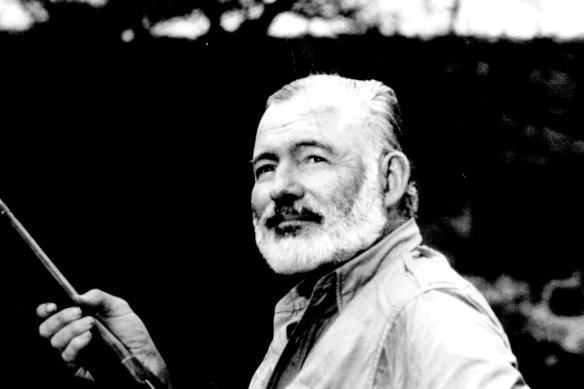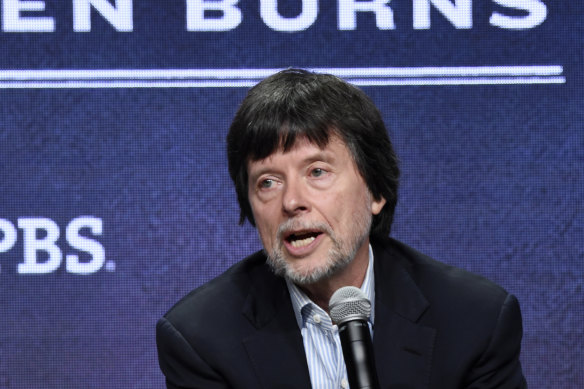This was published 2 years ago
Ken Burns rewrote the documentary rule-book; now he tackles Hemingway
By Debi Enker
Hemingway ★★★★
SBS on Demand
It seems fitting that Ken Burns should make a documentary series about Ernest Hemingway. The writer is celebrated as a force who redefined American literature. And with his nine-part series, The Civil War in 1990, Burns redefined TV documentaries.
Although it wasn’t his first screen work, The Civil War, on which Burns was the director, producer, co-writer, chief cinematographer and music director, became the most-watched documentary in US TV public-broadcasting history. It also set viewing records for SBS in Australia.
That series introduced a deceptively simple style, one that was distinctive and became inextricably associated with Burns’ work: a poetic script featuring a measured narrator; an unhurried pace; evocative use of photographs; readings from letters and diaries, often performed by actors; interviews with experts in the field, who, in the case of The Civil War were historians and in Hemingway are literary scholars and authors.

Ernest Hemingway on safari in Africa.
Since that landmark production, Burns has been prolific, turning his attention to jazz, country music, baseball, Mark Twain, the Vietnam War, the Statue of Liberty and more.
Now comes the three-part, six-hour Hemingway, six years in the making, co-directed by Burns with Lynn Novick, and written by Geoffrey C. Ward. While approached in a similar style to his previous series, the portrait of the celebrated writer, a journalist, war correspondent, magazine columnist and author of short stories, fiction and non-fiction books, also benefits from access to original manuscripts. This enables animated graphics that bring the works to life, simulating the writer’s corrections to them. As well, there are filmed sequences of the landscapes that Hemingway loved and indoor shots of desks, typewriters, pens and coffee pots that resemble still-life paintings.
Actor Peter Coyote, who has worked on many of Burns’ series since The West in 1996, again supplies the narration, with actor Jeff Daniels providing Hemingway’s voice. Among the other actors lending their voices are Patricia Clarkson as Pauline Pfeiffer, the second of Hemingway’s four wives, and Meryl Streep as his third wife, foreign correspondent Martha Gellhorn.
In addition to the chronology it offers of Hemingway’s life (1899-1961) and career, the series endeavours to separate the man from the myth of rugged masculinity that grew around him, one that he actively promoted. The image was of a hard-drinking, womanising, brawling outdoors enthusiast who relished big-game hunting and deep-sea diving, an action hero who wrote from lived experience with war, women and travel.

Ken Burns, whose pioneering The Civil War remains the most watched documentary series aired on public television in the US.Credit: Chris Pizello/Invision/AP
The other picture that emerges is of a troubled and complicated individual, a man of contradictions who destroys himself, in part by endeavouring to stay true to the image that he pursued. His first wife, Hadley Richardson, remarked that he had so many sides that he defied geometry.
The series’ first chapter, A Writer (1899-1929), spans his childhood and early years, growing up in an Illinois suburb as one of six children to a doctor who battled depression and an aspiring opera singer frustrated that her career was stifled by motherhood. It takes in his initial war experiences and injuries, his first love, his first two marriages, a formative time in Paris, the publication of his collection of short stories, travels in Spain, and early writing frustrations and publishing successes.
It also identifies the origins of his muscular writing style informed by his days at the Kansas City Star whose style manual stipulated, “Use short sentences. Use short first paragraphs. Use vigorous English.”
The second episode, The Avatar (1929-44), covers his time in Florida, his third marriage, an African safari, life in Cuba, his reverence for bull-fighting and the writing of a range of books and articles. The final chapter, The Blank Page (1944-61), spans his marriage to Time correspondent Mary Welch, the writing of The Old Man and the Sea and his declining mental health.
The series conveys Hemingway’s talent, complexity and restlessness, his search for “one true sentence” and the problems that accumulated to destroy him. Showcasing the attributes typical of Burns’ work, it also tells a sweeping story with compelling intimacy.
Hemingway is on SBS On Demand.
The Watchlist newsletter
Find out the next TV shows, streaming series and movies to add to your must-sees. Sign up to get it every Thursday.